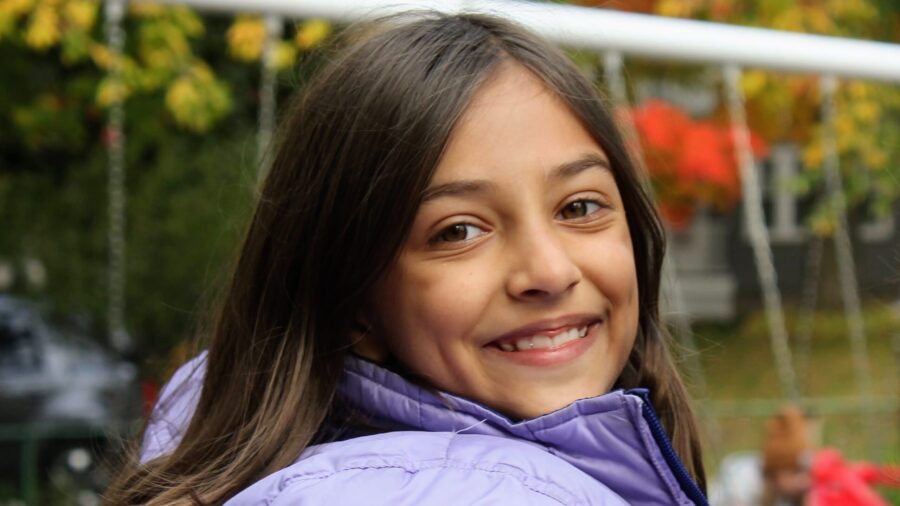A few weeks ago, my ten year-old came home from her first field hockey practice with some news that touched my heart. She said that the first half of practice she had been practicing self-criticism and comparing herself to others, but then the second half of practice, she remembered self-compassion, and she began to repeat the kind wishes in her head that we’ve been practicing together for the last few years (May I be joyful…May I be the person I wish to be…May my heart be full of love and connection…).
May I be joyful…May I be the person I wish to be…May my heart be full of love and connection.
My heart leapt with joy at her compassionate inner voice, and I thought to myself, “She’s going to be okay!” This is the same thought that I had when my now fourteen year-old began to report that she had an inner voice that soothed and encouraged her when she felt “less than” in middle school. When a child develops an inner self-compassionate voice, I know they are going to be “okay.” They have an inner ally that will soothe them during difficult times and help them to grow and change in positive ways.
It is my deepest wish that all of us – adults and children – can develop an inner self-compassionate voice that helps us to know that we are “okay” and loved. But what is the best way to help another person to develop the resource of self-compassion?
When I contemplate this question, I am reminded of the following quote by Albert Schweitzer: “Example is not the main thing in influencing others. It is the only thing.”
While helping another individual develop self-compassion involves more than just our example, the power of example cannot be overstated. This is especially true when it comes to children. The process of helping children grow self-compassion involves four steps, which are built upon the foundation of a caregiver’s self-compassion.
Four Steps to Help Children Grow Self-Compassion
- Caregivers learn the skill of self-compassion either on their own or alongside their child.
- Model self-compassion in the presence of children.
- Be the external voice that you want children to internalize.
- Children learn and practice offering themselves self-compassion.
STEP 1: Caregivers learn self-compassion.
We can’t help children to acquire a skill that we do not possess. That’s why our first step as caregivers is to grow our personal self-compassion practice. For most of us, treating ourselves with kindness when things go wrong, and lovingly encouraging ourselves to grow takes a little bit (or a lot) of training and practice. You can strengthen your self-compassionate voice by using resources such as Mindful Self-Compassion training and books such as the Mindful Self-Compassion workbook.

Jamie Lynn Tatera with her two daughters
STEP 2: Model self-compassion in the presence of children.
Modeling self-compassion as caregivers means that we appropriately name our struggles in the presence of children and model giving ourselves encouraging and/or tender support for our difficulties. This might look like giving ourselves a hug or audibly offering ourselves reassurance or support when we feel distressed. We might let kids know that we are going for a walk, calling a friend, or making ourselves a cup of tea as a kind response to our struggles. When we name and model compassionately responding to our struggles we create a bridge between children and ourselves. Our example of self-compassion lets kids know that it’s okay to struggle and that they can seek out support (including their own kindness) during difficult moments. Our self-compassionate example can then be internalized as a model for children to emulate when they struggle. As caregivers, we need to have our own self-compassion practice (step 1) in order to model self-compassion for children.
Our example of self-compassion lets kids know that it’s okay to struggle and that they can seek out support (including their own kindness) during difficult moments.
STEP 3: Be the external voice that you want children to internalize.
When you speak to children, ask yourself the question: Is this the voice that I want my child to internalize? Is this how I want children to talk to themselves in their own minds? Because children internalize the voice of their caregivers (including tone), as much as possible, we want our words to convey compassion – sometimes tenderly soothing and sometimes encouraging and motivating. When we are successful at speaking to a child in this way, our words contribute to the development of a child’s compassionate voice. When we fall short of this aspiration, as we all do, it becomes an opportunity to acknowledge our human imperfection and offer ourselves compassion. We can show children that just like them, we are on the learning team when it comes to treating ourselves and others with kindness.
STEP 4: Children learn and practice offering themselves self-compassion.
Explicitly teaching children self-compassion and scaffolding their practice can sometimes be tricky, especially when teaching our own children, but it is a vital step. Many caregivers find it helpful to use resources, such as self-compassion books or a parent-child self-compassion class to help children consciously learn and practice the skill of self-compassion. Teens can take a Mindful Self-Compassion for Teens class to learn on their own. After children have learned self-compassion practices, caregivers can begin to gently and selectively encourage children to practice self-compassion. When a child is having a difficult moment, it usually works best if caregivers first provide the child with compassionate support, and then, if the child seems receptive, invite the child to offer compassion to themselves. If a child resists practicing self-compassion, it can be helpful for the caregiver to focus primarily on the first three steps described in this article (increase caregivers’ self-compassion, model self-compassion, and use a compassionate voice with children).
It’s important that we, as caregivers, have a long-term view of children’s self-compassion development. We can normalize and offer ourselves compassion when children’s development of self-compassion is slower than we would wish. It’s important that children know that we are learning and practicing self-compassion along with them, and that it’s self-compassionate to allow ourselves to grow slowly over time.
Jamie Lynn Tatera is a certified Mindful Self-Compassion teacher with a passion for sharing self-compassion with children and their grown-ups. She is a trained Mindful Self-Compassion for Teens teacher as well as the creator and instructor of the Self-Compassion for Children and Caregivers program, a researched and approved parent-child adaptation of the Mindful Self-Compassion program. Learn more about Jamie’s work here.

